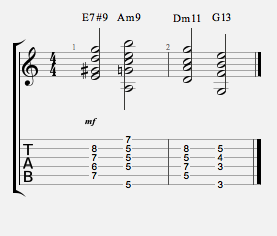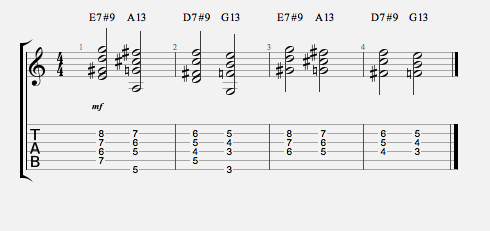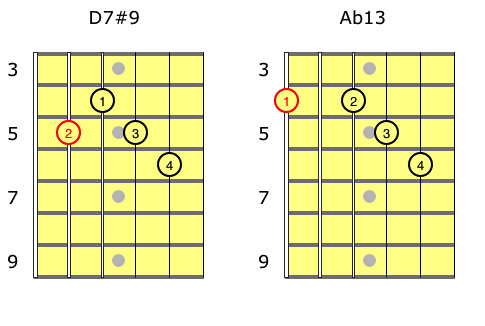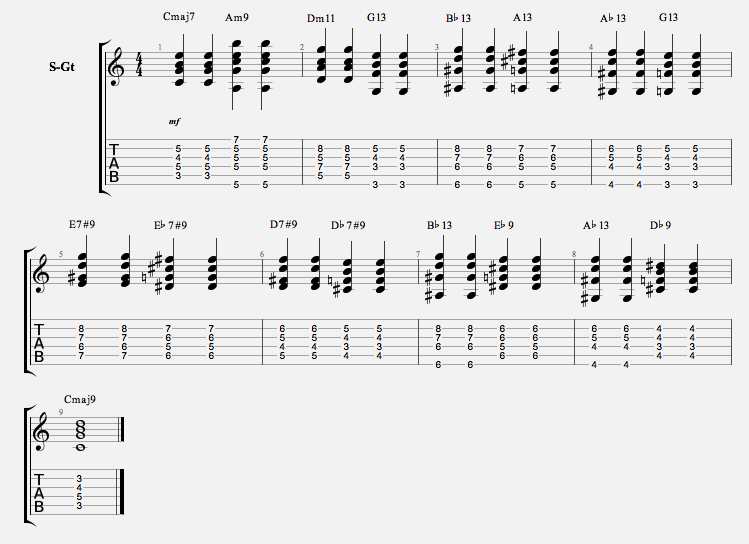The I-vi-ii-V Progression
The I-vi-ii-V is an important chord progression that forms the basis of many great songs. The chords are built from the first, sixth, second and fifth notes of a major scale.

From the C major chord scale, comes the I-vi-ii-V progression.

A very useful type of chord substitution is to replace the I chord(Cmaj7) with the iii chord (Emi7). Replacing the I chord with the iii chord is sometimes referred to as a mediant substitution. This can be done because three out of the four notes are common.
C maj7= C E G B
E Min7= E G B D

Now take the iii chord (Emi7) substitute and make it a dominant #9 chord for another option to replace the I chord (Cmaj7).

Experiment by taking the I chord and adding color tones. For example, rather than playing a Cmaj7, try using a Cmaj9, C6(playing the major 6th instead of the major 7th degree) or a C6(9).

Another substitution for the I-vi-ii-V progression is playing a dominant seventh chord in place of a minor seventh chord. Instead of playing the Ami7 and Dmi7 chord, substitute an A7 (vi chord) and a D7 (ii chord). Make sure to add all the color combinations of the dominant seventh chord to your playing (9ths,13ths, #9, b9, #5, b5).
| Cmaj7 | Ami7 | Dmi7 | G7 | original progression
| Cmaj7 | A7 | D7 | G7 | substitute a dominant chord for the vi and ii minor chord
The example below takes the dominant seventh substitutions and applies it to the I-vi-ii-V progression.

Using all the above ideas for chord substitution allows us to move chords chromatically. Lets take the I chord (Cmaj7) and substitute the iii minor chord (Emi7). We’re not done yet, now take that minor seventh chord and make it a dominant #9 chord with the minor to dominant substitute concept. Finally, take the vi and ii chord and substitute a dominant chord in place of the minor.

By changing the root notes of the dominant chords, we get a completely new set of chords to use for substitutions over the I-vi-ii-V progression. When playing the I chord, replace the root “E” with the note “Bb“. This changes the E7#9 to a Bb13.

With the vi chord, substitute the root “A” with an “Eb“, thus turning the A13 into an Eb7#9

Now replace the “D” with an “Ab” for the ii chord. The D7#9 is now the Ab13.

Finally, change the “G” with a “Db” for the V chord. The G13 is now the Db7#9.

The final example starts with our original I-vi-ii-V progression and then incorporates the chord substitutions from the above examples.

Now that we explored the I-vi-ii-V progression, here are some ideas when working on this material:
- Practice the examples of the I-vi-ii-V progression in all keys.
- When working on a chord voicing, try moving it to other string groups.
- Write out your favorite chord voicings. Work out variations, mix and match and be creative as possible.
- Practice the I-vi-ii-V substitutions over standards in your Real Book and work them into your playing.


